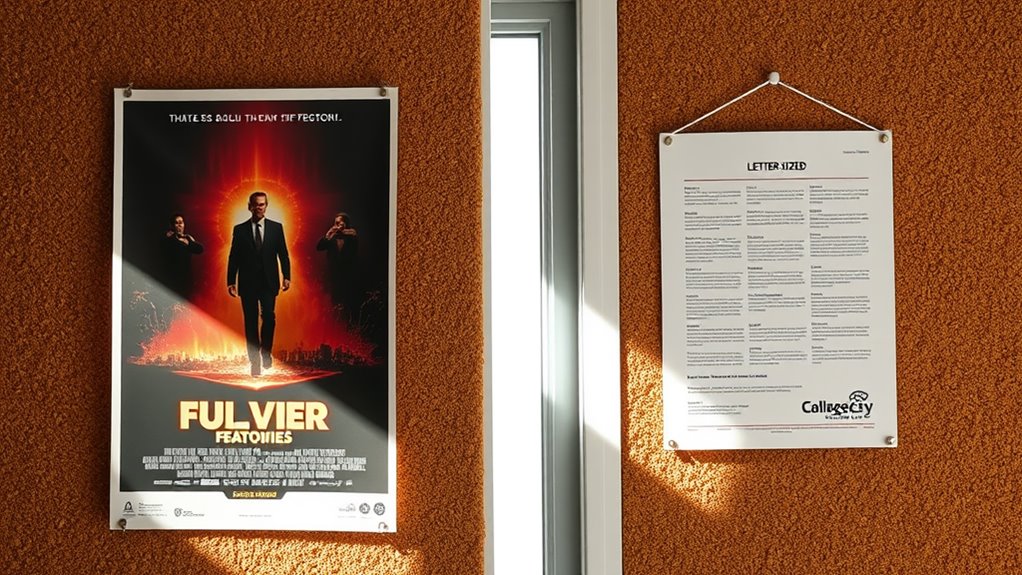A poster isn't the same as a flyer, though they're both marketing materials with distinct characteristics. Posters are larger (typically 11"x17" or bigger), designed for distance viewing, and mounted on walls for 2-4 weeks of visibility. Flyers, on the other hand, are smaller (usually 8.5"x11" or less), meant for hand distribution, and have a shorter lifespan of 1-7 days. You'll notice posters feature prominent visuals with limited text, while flyers contain more detailed information with supporting graphics. Understanding these key differences will help you choose the right format for your specific marketing needs.
Key Takeaway
- Posters and flyers are distinct marketing materials, with posters being larger (11"x17" or bigger) and flyers smaller (8.5"x11" or smaller).
- Posters focus on large visuals and minimal text for distance viewing, while flyers contain detailed information for up-close reading.
- Posters typically last 2-4 weeks and mount on walls, whereas flyers have a shorter lifespan of 1-7 days for hand distribution.
- Posters use heavier stock paper for durability, while flyers print on standard paper for cost-effective mass distribution.
- The terms "flyer" and "flier" are spelling variations of the same thing, both referring to small handbills, not posters.
Defining Each Marketing Format
Marketing materials come in various formats, with posters and flyers being two distinct promotional tools. To understand their differences, you'll need to examine each format's core characteristics and intended uses.
Key Poster Characteristics:
- Larger format, typically 11"x17" or bigger
- Designed for viewing from a distance
- Mounted on walls or display boards
- More durable, often printed on heavier stock
- Contains prominent visuals with limited text
- Average lifespan of 2-4 weeks in public spaces
Flyer Characteristics:
- Smaller format, usually 8.5"x11" or smaller
- Created for hand-to-hand distribution
- Often distributed in bulk quantities
- Printed on standard paper stock
- Contains detailed information with supporting visuals
- Average lifespan of 1-7 days
While you might notice some overlap in their marketing purposes, posters and flyers serve different functions in your promotional strategy. Posters work best when you need to grab attention from afar and maintain a longer-lasting presence. In contrast, flyers excel at delivering detailed information directly to your target audience's hands, making them ideal for time-sensitive promotions or event announcements.
Size and Design Differences
The physical dimensions of posters and flyers immediately set them apart in both appearance and impact. You'll find that posters typically range from 18×24 inches to 27×41 inches, while flyers are commonly letter-sized (8.5×11 inches) or smaller.
Key Size Differences:
- Posters prioritize large-format visibility from a distance
- Flyers optimize for hand-to-hand distribution
- Standard poster sizes allow for wall mounting and framing
- Flyer dimensions fit easily in folders, mailboxes, and displays
Design Distinctions:
- Your poster designs should include:
- Large, bold headlines visible from 10+ feet away
- High-resolution images that maintain quality at scale
- Simplified messaging with 40% white space
- Your flyer layouts should feature:
- Detailed text that's readable at arm's length
- Multiple content sections with clear hierarchy
- Contact information and call-to-action prominence
When you're choosing between formats, consider that posters command attention through size and impact, while flyers excel at delivering detailed information in a compact, portable format that's cost-effective for mass distribution.
Usage and Distribution Methods

While both posters and flyers serve promotional purposes, their distribution methods differ considerably based on their intended reach and impact. You'll typically display posters in fixed locations where they can attract attention from passersby, such as bulletin boards, walls, or storefront windows. Flyers, however, offer more versatile distribution options, allowing you to reach your audience through direct handouts or mailbox drops.
Evaluate these key distribution approaches that impact your marketing strategy:
- You'll achieve 45% higher engagement when you place posters at eye level in high-traffic areas, like shopping malls or transit stations
- Your flyers can reach 3x more people through strategic door-to-door distribution compared to static poster placement
- You'll notice that posters typically remain visible for 2-4 weeks, while flyers drive immediate action within 48 hours
- Your distribution costs can be 60% lower with flyers when targeting specific neighborhoods
When planning your campaign, you'll need to assess foot traffic patterns for posters and distribution routes for flyers. You can maximize your reach by combining both methods, using posters for sustained visibility and flyers for targeted outreach.
Digital Vs Print Applications
Both posters and flyers have evolved beyond traditional print media into digital formats, transforming how businesses reach their audiences. You'll find that digital versions offer unique advantages in today's market, including instant distribution and trackable engagement metrics.
Digital Applications:
- E-posters for virtual conferences and online events
- Social media-optimized flyer designs for Instagram and Facebook
- Interactive PDF posters with clickable links
- Email-friendly flyer formats for newsletters
- Digital signage displays for retail environments
Print Applications:
- Traditional large-format posters for outdoor advertising
- Hand-distributed flyers for local marketing
- Point-of-sale promotional materials
- Event-specific printed materials
- Trade show displays and materials
When you're choosing between digital and print formats, consider that digital versions typically cost 60% less to produce and can reach audiences instantly. However, print materials still maintain a 70% higher retention rate among viewers. You'll want to analyze your specific needs, as many successful campaigns now utilize both formats strategically. For example, you might use QR codes on printed materials to bridge the gap between physical and digital experiences, creating an integrated marketing approach.
Choosing the Right Format

Selecting between posters and flyers requires careful consideration of five key factors: your target audience, distribution method, budget constraints, design complexity, and intended lifespan of the marketing material.
When you're making your choice, consider how your audience will interact with the material. Posters work best in high-traffic areas where people have time to absorb detailed information, while flyers excel in direct-to-consumer situations that require quick engagement.
To determine which format will serve your needs best, evaluate these emotional impact factors:
- Size Impact – Large-format posters command attention and create a sense of importance
- Personal Connection – Hand-delivered flyers foster direct engagement with potential customers
- Memorability – Well-designed posters can become talking points and lasting brand ambassadors
- Immediacy – Flyers create a sense of urgency and prompt quick action
You'll want to match your format to your distribution strategy. If you're planning to mail materials or distribute them at events, flyers are your practical choice. For sustained visibility in specific locations, such as retail spaces or community boards, posters will deliver better results with their larger format and durability.
Conclusion
Perfectly picking your promotional piece depends on your particular purpose. You'll find posters, flyers, and fliers each serve specific scenarios, but they're not strictly synonymous. While you can use them interchangeably in casual conversation, understanding their distinct differences will help you choose the right format for your message. Whether you're promoting an event or advertising a business, match your medium to your marketing mission for maximum impact.









